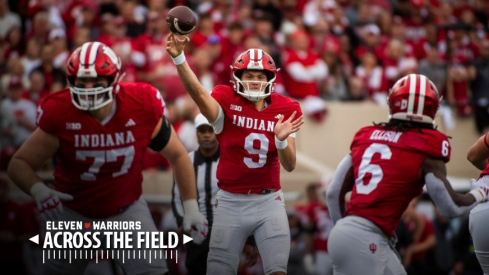 They've got this. Maybe.
They've got this. Maybe.Fifteen years ago the Buckeyes took the field to start the 1996 season with significant changes all along the offensive side of the ball. At quarterback, they would be without Bobby Hoying for the first time in what seemed like forever; Hoying had commandeered the offense for most of the previous three seasons. In his place, Stan Jackson, who looked extremely shaky in mop-up duty the previous year (a 56-0 halftime lead against Iowa morphed into a 56-35 final score on his watch) would compete with Mark Garcia and converted defensive back juco transfer Joe Germaine. The drop-off was inevitable; it was only its depth that was undetermined.
Those Buckeyes would also be without their leading rusher from 1995 who also happened to be the best college football player on any team the previous year. Relative unknowns Pepe Pearson, Joe Montgomery and Jermon Jackson were tapped to fill in and line up behind another space left vacant by the departure of Nicky Sualua, the best blocking fullback the Buckeyes had had in ages. Oh, also missing that year would be the reigning Biletnikoff winner as well as the leading tight end that had been taken ninth overall in the NFL draft. But other than all that, everything was expected to be juuuust great.
The loss of Hoying, Eddie George, Sualua, Terry Glenn and Ricky Dudley should have been impossible to recover from; each of those players left campus having turned in one of the best seasons ever witnessed at their respective positions in Ohio State history. However, despite the exodus of elite players the 1996 Buckeyes still somehow managed to duplicate the previous season’s output and run the table up until the Michigan game, which in the 1990s is unkindly referred to as “the usual.”
By contrast, the 2011 Buckeyes will endure the absence of five gratuitously tattooed starters for five games and should take the field in much better position for success. Joe Bauserman, Kenny Guiton, Taylor Graham and Braxton Miller have far more upside in aggregate than any of the quarterbacks who were poised to step in for Hoying (Garcia never could stay healthy while Jackson was a steady underachiever, leaving Germaine to emerge as the unlikely Buckeye legend).
Pryor took over for Todd Boeckman at USC after Boeckman appeared to be turning in his sixth consecutive bad game going back to the previous season’s win at Happy Valley. Bauserman, a grizzled veteran, along with Guiton and Graham all have the luxury of experience in their rear view. By all accounts, Miller is a better quarterback right now than Pryor was entering college, with the added bonus of having that same Pryor attribute of making everyone else on the field look slow and, often, stupid.
Miller also wears a Block O arm tattoo that’s rivaled in its artistic complexity by Pryor’s. Thankfully Miller does not have any Ohio State awards to barter with just yet, otherwise we could be creating more parallels here than we already are.
Boom Herron was a starter on a team already rife with tailback talent. His temporary banishment is offset by the abundance of capable backs itching to get more carries. Jordan Hall, Jamaal Berry, Rod Smith and Carlos Hyde would already have more yardage at any other Big Ten school. It doesn’t require a full dissertation to support this position; Herron’s absence for the first five games of the 2011 season is generally accepted as the least painful, let alone with Zach Boren clearing space ahead of them. Needless to say, Eddie was a bigger loss and Pearson et al were no better than equal replacements to the current lot.
DeVier Posey was a bit of an enigma in 2010, routinely quitting on routes, dropping passes and playing a noticeable second fiddle to team MVP Dane Sanzenbacher both in terms of opportunities as well as production. Ohio State will enter 2011 with its most unknown and non-validated receiving corps since Jim Tressel’s first year. This catch is that this would have been the case even with Posey in the lineup on day one.
The suddenly veteran Corey Brown, the rangy T.Y. Williams and whoever else who wants it is going to get it. Demetrious Stanley and freshman David Boston came out of practically nowhere in 1996. Those vacuous spaces don’t tend to stay empty very long.
Then there’s Mike Adams. Adams’ light turned on halfway through last season and he ended the year locking down his tackle position in a manner that suggests his loss will be felt the greatest. There are angrier, quicker-maturing youthful beast-men prepared to pick up the slack, but it isn’t the brand of now-proven commodity that Adams became last year. One of the strengths of that 1996 team was the veteran talent on both sides of the ball. And the personnel parallel stops, abruptly.
Substitute a handful of key players from the Buckeyes’ roster with backups and the 2011 team is still capable of going 5-0. It’s an advantage of recruiting; by the grace of God the Tat Five only included one offensive lineman. Give this roster nine months to prepare mentally and physically for this reality and that five-game penance is going to be a far cry from being a fiery baptismal. All of the four suspended offensive players could have left for the NFL. Ohio State has recovered from far worse than this.
There are two real wildcards at play here, and neither of them is the missing players. The first one is the missing Tressel. Count me among those who believe Nic Siciliano is a quarterback coach in title only; it’s Tressel that builds, maintains and drives the bus. Tressel is more of a wildcard because the Tressel system is predicated on steady game stewardship with bonus points for bailing out offense with legs.
Both Guiton and especially Miller are capable of doing so with only the latter being almost comparable to Pryor’s wizardry in that capacity. The playcalling is practically secondary; the in-game quarterback tutelage by Siciliano for his newly-minted starter(s) is what could be dicey.
When the sixth game of 1996 kicked off (a laugher in West Lafayette) those leaders from the 1995 season were all still absent and the team was rightfully operating as though they weren’t coming back. I imagine the 2011 Buckeyes will function under similar, though radically artificial auspices.
Come September, the two in-state little sisters on the schedule along with Miami, Colorado and Michigan State will not face a scarlet and gray damsel in distress wishful for its suspended players. What they’re going to get is going to be a lot angrier and significantly less entitled than what they’d be facing if tattoos had never gotten fashionable, with that added wildcard of how the chosen quarterback is coached-up in the heat of battle.
Those five opponens will, however, be insulated from and avoid the second wildcard to this Tatgate drama: What’s going to happen to Ohio State when those banished players finally return to the field on gameday in October.

